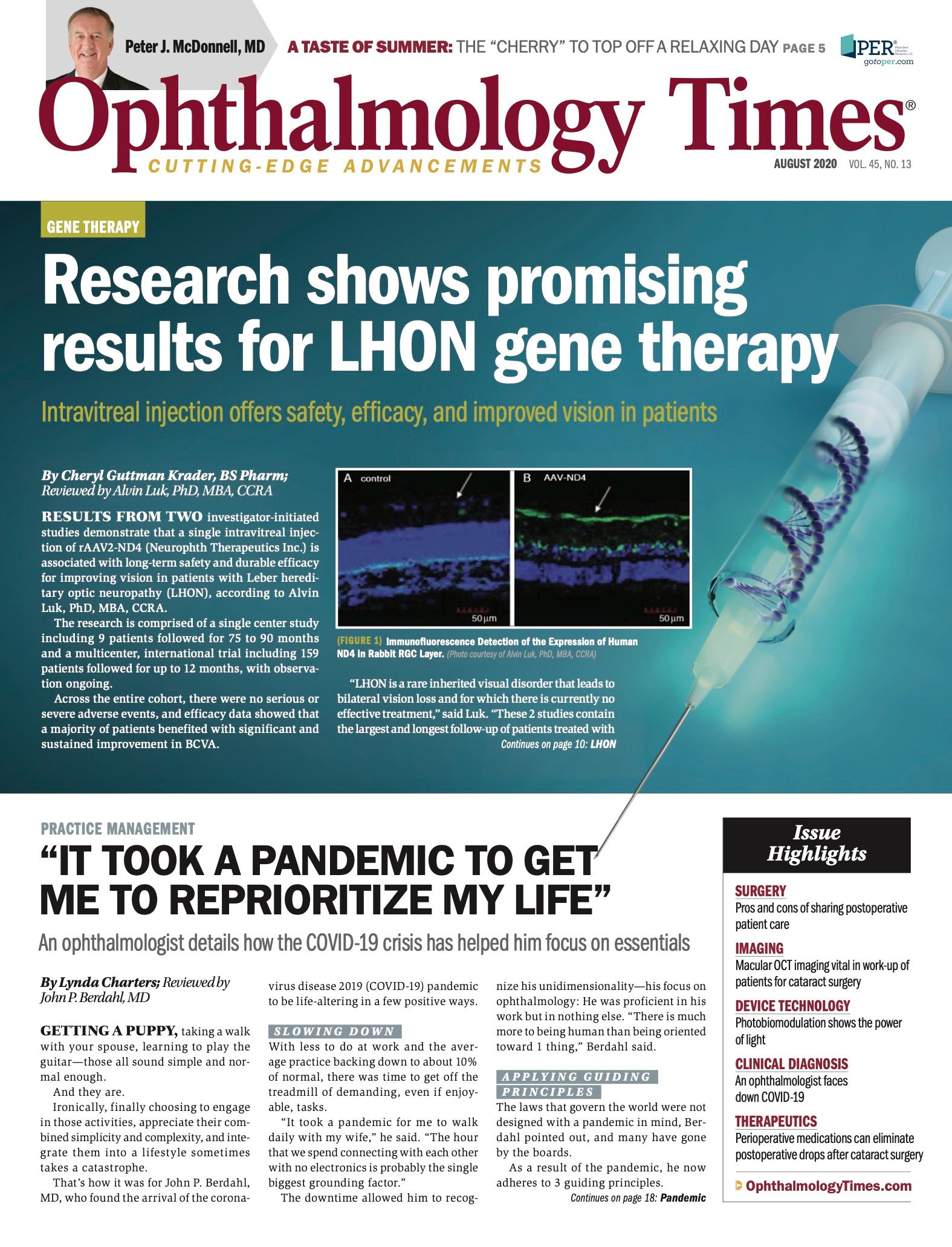Publication
Article
Digital Edition
Pearls to educate patients about ocular telemedicine options
Author(s):
COVID-19 pandemic is accelerating cultural paradigm shift for medical professionals


Special to Ophthalmology Times®
The combination of rising care costs and rapidly evolving technology is culminating in a paradigm shift for health care systems across the world—1 more consumer-driven, in which patients and members are heavily engaged in directing when, where, and how they receive care.
Speeding up this shift is the coronavirus disease 2019 (COVID-19) pandemic, which has left many patients unable to easily access in-person care for nonemergencies.
Related: Study finds millions of Americans to lose health insurance by end of 2020 due to COVID-19 pandemic
As a result, telemedicine has become central to conversations around care delivery and access, and ophthalmology is not immune.
In fact, 69% of health plan executives surveyed in Versant Health’s inaugural Vision Wellness Study say that being able to use technology to contact eye doctors for advice and information has the greatest impact on members’ receptivity to purchasing vision insurance.
Technology that supports ocular telemedicine has evolved at an unprecedented pace in response to meeting patient needs in the pandemic, highlighting the important role that vision health serves in diagnosing and maintaining overall patient health.
However, many patients may be delaying much-needed ocular care because of their fear of social contact, coupled with misconceptions about the telemedicine options available to them.
Although ophthalmologists have no influence over the former, they can have a positive impact on the latter.
Here are 3 considerations for ophthalmologists looking to better educate patients about their ocular telemedicine options.
Related: Clearing hurdles to large-scale telemedicine adoption
1. Ocular telemedicine has evolved beyond only synchronous care.
The term ocular telemedicine comprises a wide range of evolving eye care capabilities, from performing a virtual eye exam to using an app to consult with an ophthalmologist.
Most importantly, ocular telemedicine is not limited to synchronous, or real-time, communication.
One of the most impactful changes to the modern understanding of ocular telemedicine has been the move from allowing only synchronous methods of communication to including asynchronous communication and home monitoring in approved modalities.
More patients can now get quick access to and be insured for needed care.
For example, a synchronous eye exam via telemedicine may be the best option for an elderly patient residing in a nursing home during the COVID-19 pandemic who is experiencing eye pain, redness, and discharge.
An in-residence, technology-enabled, real-time emergency eye exam with video and audio communication allows the patient to stay safe from exposure.
Related: COVID-19: Companies offering new technology to connect physicians with patients
However, an asynchronous approach, which is not carried out in real time, may be best for a patient who is living with diabetes and experiencing blurred vision.
In this case, remote retinal imaging can be performed at the patient’s convenience outside of eye care providers’ offices, including at point-of-service locations like a CVS MinuteClinic, and digitally evaluated by their ophthalmologist once results are ready.
Home monitoring, or the ongoing assessment of eye health, would be appropriate for a homebound patient who has intermediate-stage macular degeneration and is experiencing new-onset blurred vision.
For people with eye conditions that can become worse over time, this option allows them to monitor their eye health at home and transmit the data to their ophthalmologists, only scheduling in-office visits when absolutely necessary.
Educating patients on these differences in their ocular telemedicine options helps ophthalmologists ensure that their patients are empowered to receive care, even in the most challenging of environments.
Related: Telemedicine continues to make waves in ophthalmology
2. Policies typically drive access to ocular telemedicine.
Access to ocular telemedicine is as much about the policies established to ensure that the care provided is appropriate and reimbursable as it is about the technologies.
In recent years, national, state, and private health insurance policies have been expanding approval for the use of remote technologies that would traditionally require in-person visits, and the COVID-19 pandemic has only increased the need to quickly expand those policies.
In March 2020, the Centers for Medicare & Medicaid Services broadened access to Medicare telemedicine in response to the pandemic to allow a wider range of services to be covered, as people were unable to leave their homes.
Still, when it comes to ocular telemedicine specifically, there are state-by-state limitations on the type of eye care that can be reimbursed by insurers.
Ophthalmologists and their teams can play an important role in educating patients on how these policies impact access.
Related: Telemedicine forum helps ophthalmologists stay connected amid COVID-19
3. Ocular telemedicine does not entirely replace in-person ophthalmology care.
Telemedicine’s mounting growth makes sense when considering the benefits to all involved, including convenience, easily trackable data, and cost-savings.
However, ocular telemedicine, in its current stage of development, cannot entirely replace the value of in-office visits with ophthalmologists.
Rather, it enhances visits by strengthening the ongoing relationship between ophthalmologists and their patients, particularly in situations such as the COVID-19 pandemic where large segments of the population are vulnerable to diseases and viruses.
Although some cases allow for remote care, others require in-person care for ophthalmologists to sufficiently diagnose the vision health, and potential overall health, issues at hand.
Looking ahead, people will still want some form of in-person human connection with their care professionals, including ophthalmologists, as it builds reassurance and trust.
Related: How one surgeon is integrating recent retina advances in COVID-19 (ASRS 2020)
That may not be immediately possible in the COVID-19 world, but looking beyond the pandemic, ophthalmologists are critical guides for patients in understanding what types of care can be accomplished via ocular telemedicine and when an in-person visit would yield better outcomes. A mix of both options is likely to be the future of ophthalmology.
Ocular telemedicine is still evolving, but that evolution is being quickened by the COVID-19 pandemic, and some fundamental changes to care access and delivery are likely here to stay for the ophthalmology community.
Ophthalmologists have an important role in not just leading the future of ocular telemedicine, but also in helping their patients understand their opportunities for tapping into it.
About the author
Mark Ruchman, MD
e:mark.ruchman@versanthealth.com
Ruchman is the chief medical officer at Versant Health. He provides all medical and clinical oversight, which includes quality improvement, clinical guidelines, and accreditation standards.

Newsletter
Don’t miss out—get Ophthalmology Times updates on the latest clinical advancements and expert interviews, straight to your inbox.





